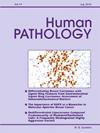WITHDRAWN: Atypical Intraductal Proliferation (AIP) of the Prostate: Findings in Repeat Biopsy or Radical Prostatectomy in Patients who Met Pathologic Criteria for Active Surveillance
IF 2.6
2区 医学
Q2 PATHOLOGY
引用次数: 0
Abstract
The Publisher regrets that this article is an accidental duplication of an article that has already been published, https://doi.org/10.1016/j.humpath.2025.105841
The duplicate article has therefore been withdrawn.
The full Elsevier Policy on Article Withdrawal can be found at
非典型前列腺导管内增生(AIP):在符合主动监测病理标准的患者中重复活检或根治性前列腺切除术的发现。
“非典型导管内增生”(AIP)的临床意义尚不确定,当在前列腺穿刺活检中发现无导管内癌(IDC-P)或中/高级别前列腺癌(PCa)时。一项回顾性研究确定了168例诊断为AIP的患者。单纯AIP 25例(15%),其余合并PCa。对单纯AIP、AIP和分级组(GG)1、AIP和GG2 PCa患者在12个月内进行随访活检或RP [
本文章由计算机程序翻译,如有差异,请以英文原文为准。
求助全文
约1分钟内获得全文
求助全文
来源期刊

Human pathology
医学-病理学
CiteScore
5.30
自引率
6.10%
发文量
206
审稿时长
21 days
期刊介绍:
Human Pathology is designed to bring information of clinicopathologic significance to human disease to the laboratory and clinical physician. It presents information drawn from morphologic and clinical laboratory studies with direct relevance to the understanding of human diseases. Papers published concern morphologic and clinicopathologic observations, reviews of diseases, analyses of problems in pathology, significant collections of case material and advances in concepts or techniques of value in the analysis and diagnosis of disease. Theoretical and experimental pathology and molecular biology pertinent to human disease are included. This critical journal is well illustrated with exceptional reproductions of photomicrographs and microscopic anatomy.
 求助内容:
求助内容: 应助结果提醒方式:
应助结果提醒方式:


